Improved Order of Red Men
The Improved Order of Red Men is a fraternal organization established in North America in 1834. It claims direct descent from the colonial era Sons of Liberty.[2] Their rituals and regalia are modeled after those assumed by men of the era to be used by Native Americans. Despite the name, the order was formed solely by, and for, white men.[2] This whites-only rule was part of their bylaws until 1974, when the all-white clause was eliminated. Their current position is that they are now open to people of all ethnic backgrounds.[2] In 1935 the organization claimed a membership of about half a million, but it has now declined to a little more than 15,000.
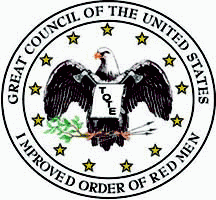 | |
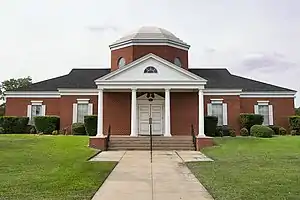 Improved Order of Red Men Museum and Library, Waco, Texas | |
| Predecessor | Sons of Liberty (claimed) Society of Red Men (c. 1813) |
|---|---|
| Formation | 1834 |
| Founded at | Baltimore |
| Type | Fraternal |
| Purpose | Patriotism, charity, friendship |
| Headquarters | Waco, Texas |
| Website | redmen |
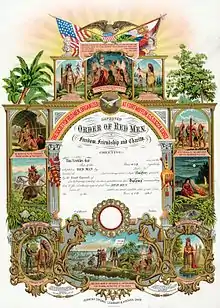

History
On December 16, 1773, a group of colonists — all men, and members of the Sons of Liberty — met in Boston to protest the tax on tea imposed by England. When their protest went unheeded, they disguised themselves as their idea of Mohawk people, proceeded to Boston harbor, and dumped overboard 342 chests of English tea. (See Boston Tea Party.)[3]
In the late 18th century, the Tammany Societies, named after Tamanend, were formed. The most well-known of these was New York City's Society of St. Tammany, which grew into a major political machine known as "Tammany Hall."
For the next 35 years, the original Sons of Liberty and the Sons of St. Tamina groups went their own way, under many different names.
Around 1813, a disenchanted group created the philanthropic "Society of Red Men" at historic Fort Mifflin in Philadelphia.
The organization grew in the 1820s. Parallel lines of advancement were offered in the Order of Red Men: a series of military titles and a set of “Indian rankings.”[4]
Class and ethnic differences introduced by new immigrants, anti-Masonic persecutions, attacks on fraternal groups based on excessive drinking, and, ultimately, a wide-spread cholera epidemic in 1832 led to the decline of the organization.
In 1834, the Improved Order of Red Men (IORM) was started as a revival in Baltimore.[5] It was focused on temperance, patriotism and American History. In 1835, with only two groups in place (called "tribes" by the IORM), a larger IORM was organized. Unlike the original Order, the IORM uses only expanded Native American titles.[4] Rather than the public display of Native American costumes, the IORM uses its regalia in private gatherings.[4]
In 1886, its membership requirements were defined in the same pseudo-Indigenous phrasing as the rest of the constitution:
Sec. 1. No person shall be entitled to adoption into the Order except a free white male of good moral character and standing, of the full age of twenty-one great suns, who believes in the existence of a Great Spirit, the Creator and Preserver of the Universe, and is possessed of some known reputable means of support.[6]
In one 1886 "tribe", a member's 12 cent a week dues went into a fund which was used to pay disability benefits to members at a rate of about "three fathoms per seven suns" ($3/week) for up to "six moons" (6 months) and then two dollars a week. Some medical care ("a suitable nurse") was available, and also a death benefit of one hundred dollars. The fund was invested in bonds, mortgages, and "Building Association Stock". Meetings were held weekly on Friday nights.[6]
Organization
The Order has a three tiered structure. Local units are called "tribes" and are presided over by a "Sachem" and a board of directors. Local meeting sites are called "Wigwams". The state level is called the "Reservation" and governed by a "Great Sachem" and "Great Council" or "Board of Chiefs". The national level is the "Great Council of the United States". The Great Council consists of the "Great Incohonee" (president), and a "Board of Great Chiefs", which includes the "Great Senior Sagamore" (first vice-president), "Great Junior Sagamore", "Great Chief of Records" (secretary), "Great Keeper of the Wampum" (treasurer) and "Prophet" (past president). The headquarters of the Order has been in Waco, Texas, since at least 1979.[7] They maintain an official museum and library in Waco.
Auxiliaries and side degrees
A side degree of the order was founded in 1890 as the National Haymakers' Association.[8] There was also once a uniformed division called the Knights of Tammany, as well as a group called the Chieftains League, which consisted of members who had been exalted to the Chief Degree (see below) and were in good standing within their respective "tribes".[2]
In 1952, the Order created the Degree of Hiawatha, as a youth auxiliary for males 8 and up. Most of the members of the Degree of Hiawatha were concentrated in New England. In 1979 there were less than 5,000 members in approximately 125 "Councils".[9]
The Order female auxiliary is the Degree of Pocahontas and dates to the 1880s and the Degree of Anona, a junior order of the Degree of Pocahontas, was formed in 1952.[10]
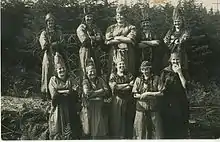
Membership
The Improved Order of the Red Men grew in membership in the late 19th century. It reached 519,942 members in forty-six states in 1921, but had declined to 31,789 in 32 states in 1978[11] and to 15,251 by 2011.[12]
Until 1974, the Order was open to whites only. That year the 106th Great Council of the United States eliminated the all-white clause in what was called a "turning point for the order". In the present-day, the Improved Order of Red Men is open to people of all ethnic backgrounds.[2]
Rituals
The order itself claims direct descent from the Sons of Liberty, noting that the Sons participated in the Boston Tea Party dressed as their idea of "Indians". Thus, they continue to dress as "Indians" and use Native American terminology, despite being a non-Native organization.[2]
The group's ritual terminology is derived from language they believe is used by Native Americans, though it also shows the influence of Freemasonry. Outsiders are called "Palefaces", to open a meeting is called "kindling the fire", officers' installations are called "Raising up of Chiefs" and voting is called "twigging". The Masonic influence is seen in the three basic degrees – Adoption, Warrior and Chief. There is also a fourth degree, Beneficiary, for insurance.[13]
Calendar system
Originally, the society used the Hebrew Anno Mundi system for calendar year numbering when dating their documents, rather than AD (note: the Redmen did not use the Common Era reference); however, in CE 1865, a new system was devised and adopted, known as the "Great Sun of Discovery" (GSD). The first year of the system, known as GSD 1, was the year that Christopher Columbus arrived in the Americas, namely AD 1492.[14] In this system, years were known as "great suns" and months were called "moons", each with their own epithet, e.g. "Cold Moon" for January, but the length of these years and months conformed to the conventional Gregorian calendar.[15]
Philanthropy and positions
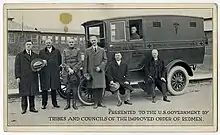
The order has historically opposed federal welfare programs, waste in government and Communism. However, there are examples of substantial socialist participation in the organization in pockets of the United States; for example, in southern West Virginia, during the build up to the West Virginia Mine Wars, "the Improved Order of Red Men [was] . . . the most comfortable lodge for Socialist miners and other radical workers."[16]
After the Civil war in West Virginia, the Improved Order of Red Men became a fraternal organization of some notoriety for vigilante activity. The Red Men Act, West Virginia's anti conspiracy law, was passed in response to a groundswell of such violence.[17] Occasionally this vigilante activity included the use of red masks over their faces.[18]
The IORM supported the founding of the Society of American Indians in 1911 and helped organize the SAI's first two conferences.[19]
Offshoots
Independent Order of Red Men
In 1850, the German-language, "Metamora Tribe of Baltimore", refused to pay a benefit, even though the Great Councils of Maryland and the United States decided that it was legal and proper for them to do so. The group then surrendered its charter and formed a new, German-speaking Independent Order of Red Men. It asked the other German-language groups (or Stamms) to join the new group, but few did so. The Independent Order had a height of 12,000 members, though in the 1880s many Stamms returned to the Improved Order.[20] It still existed in 1896, but according to Albert C. Stevens it gave "no sign of vigorous growth".[20] In the early 1920s, Arthur Preuss could not get into contact with them, but felt it probably still existed.[21]
Afro-American Order of Red Men
In 1904, another group called the Independent Order of Red Men emerged in Virginia, this time composed entirely of African Americans. When the Improved Order objected to the use of the name, the leader of the group, R. M. Spears, had the charter withdrawn and renamed the group the "Afro-American Order of Red Men and Daughters of Pocahontas". The Virginia IORM still apparently considered an injunction against the new group, but it is unclear how the episode turned out.[22] A Tribe #23 based in Metompkin, Virginia is attested by the existence of a ribbon badge in the collection of Theda Skocpol, suggesting that the group had at least 23 local "tribes" in the state. The badge is identical to the ones worn by the IORM, except with the AAORM initials.[23]
Notable members
Gallery
Notes and references
- Captions: "Red men administer no oaths binding you to any political or religious creed. They bind neither your hands nor your feet. As you enter their wigwams so you depart a free man." "If a stranger enter your abode welcome him and forget not always to mention the Great Spirit." "And make the forest as free to you as the air is to the eagle." "To adopt orphans and bring them up in various ways is pleasing to the Great Spirit." "Be merciful to the stranger found astray in the forest." "It is the will of the Great Spirit that you reverence the aged." "The three sisters: our life - our supporters. Unbroken faith." "And hath made of one blood all nations of men for to dwell on the face of the earth." "The Great Spirit spoke and the whirlwind was still. This belt preserves our words."
- Schmidt 1980, p. 288.
- "Boston Tea Party Historical Society".
- Deloria, Philip J. (1998). Playing Indian. Yale University Press. pp. 59–65.
- "Founding dates of fraternal organizations".
- Constitution, By-laws and Rules of Order, Sciota Tribe, No. 214, Improved Order of Red Men, of Pennsylvania. Frankford Avenue and Aramingo Street, Philadelphia, Pennsylvania: Shaw Brothers, Printers. 1886.
- Schmidt 1980, p. 286, 288–289.
- Alan Axelrod International Encyclopedia of Secret Societies and Fraternal Orders New York; Facts on File, inc 1997 p.114
- Schmidt 1980, p. 157, 288.
- Schmidt 1980, p. 43, 260.
- Schmidt 1980, p. 287.
- "Great Council of U.S. Improved Order of Red Men" entry, Associations Unlimited database, Gale Research Co., 2011, cited at Gnerre, Sam (2 March 2011). "Improved Order of Red Men". South Bay Daily Breeze. Retrieved 3 September 2014.
- Schmidt 1980, p. 287–288.
- Lindsay, George W (1893), Official History of the Improved Order of Red Men Archived 2016-03-04 at the Wayback Machine, Reprint, London: Forgotten Books, 2013. (pp. 494-5)
- Mencken, Henry Louis (1945), The American Language: Supplement I-II, Alfred A Knopf, New York (p. 185)
- "Red Men and Rednecks the Fraternal Lodge in the Coal Fields". Archived from the original on 2020-11-19. Retrieved 2022-10-03.
- "CALHOUN REDMEN BECAME VIGILANTES - Legitimate Lodge Turns Brutal". www.hurherald.com. Retrieved 2023-01-16.
- "The Daily Register 29 Dec 1879, page 3". Newspapers.com. Retrieved 2023-01-16.
- Todd Leahy and Raymond Wilson Historical Dictionary of Native American Movements Lanham, Md.: Scarecrow Press p.75
- Stevens 1907, p. 262.
- Preuss, Arthur (1924). A Dictionary of Secret and other Societies. St. Louis: B. Herder Book Co. p. 192.
- Skocpol, Liazos & Ganz 2006, p. 44–45.
- Skocpol, Liazos & Ganz 2006, p. 236.
- Eastman, Frank Marshall (1922). Courts and Lawyers of Pennsylvania: A History, 1693-1923, Volume 4. New York: The American Historical Society, Inc. p. 358. Retrieved 29 July 2018.
- Jordan, John W. (1914). A History of Delaware County Pennsylvania and Its People. New York: Lewis Historical Publishing Company. pp. 634–637. Retrieved 19 August 2018.
- Bartlett, Ichabod Sargent (1918). History of Wyoming. Vol. 2. Chicago: S. J. Clarke Publishing Company. pp. 55–56.
Bibliography
- Schmidt, Alvin J. (1980). Fraternal Organizations. Westport, CT: Greenwood Press.
- Skocpol, Theda; Liazos, Ariane; Ganz, Marshall (2006). What a mighty power we can be: African American fraternal groups and the struggle for racial equality. Princeton: Princeton University Press.
- Stevens, Albert C. (1907). Cyclopedia of Fraternities: A Compilation of Existing Authentic Information and the Results of Original Investigation as to the Origin, Derivation, Founders, Development, Aims, Emblems, Character, and Personnel of More Than Six Hundred Secret Societies in the United States. New York: E. B. Treat and Company.
External links
- Improved Order of Red Men official site
- Official History of the Improved Order of Redmen 1893
- Guide to The Great Council of Kentucky of the Improved Order of Red Men record, 1905-1968 housed at the University of Kentucky Libraries Special Collections Research Center
.jpeg.webp)


.jpg.webp)

.jpeg.webp)
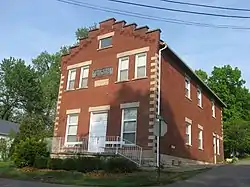
.jpg.webp)